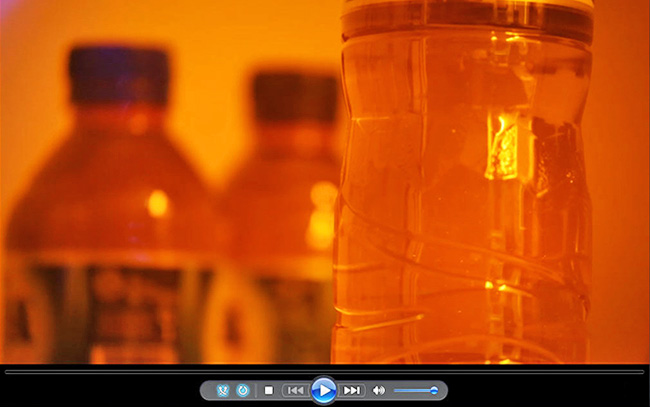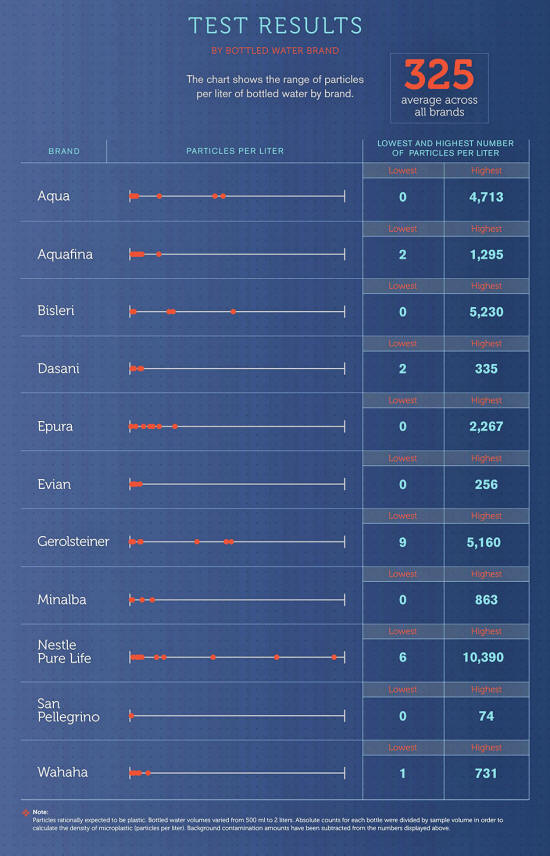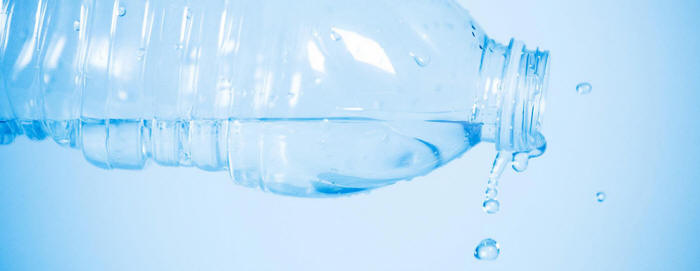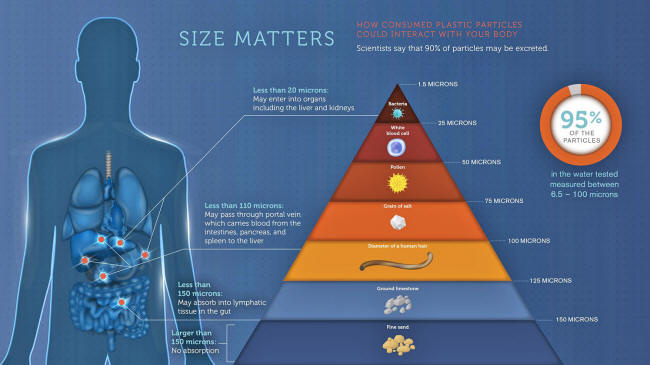|

by Chris Tyree and
Dan Morrison
November
2018
from
OrbMedia Website

Fluorescing microscopic pieces of plastic
swirl
in a bottle of water during tests
at The
State University of New York in Fredonia.
The mercury sprints past 30 degrees Celsius most days on Brazil's
world-famous Copacabana Beach.
Marcio Silva has walked untold miles here
selling bottled water from a cooler
to local sun-worshippers and sunburnt tourists alike - half a liter
of convenient refreshment and defense against dehydration.
"I drink water
because water is life, water is health, water is everything,"
says Silva, who is 51. "I drink it and sell it to others."
"I don't want to sell something bad to people."
The water looks clear,
clean, unsullied. So does the bottle.
For some, it's a
container of convenience. For others, it's a hedge against dirty or
unsafe tap water.
Bottled water is marketed as the very essence of purity. It's the
fastest-growing beverage market in the world, valued at US$147
billion1 per year.
But new research by
Orb Media, a nonprofit journalism
organization based in Washington, D.C., shows that a single bottle
can hold dozens or possibly even thousands of microscopic plastic
particles.
Tests on more than 250 bottles from 11 brands reveal contamination
with plastic including polypropylene, nylon, and polyethylene
terephthalate (PET).
When contacted by reporters, two leading brands confirmed their
products
contained microplastic, but they
said Orb's study significantly overstates the amount.
For plastic particles in the 100 micron, or 0.10 millimeter size
range,
tests conducted for Orb at the State
University of New York revealed a global average of 10.4
plastic particles per liter.
These particles were
confirmed as plastic using an industry standard infrared microscope.
The tests also showed a much greater number of even smaller
particles that researchers said are also likely plastic.
The global average for
these particles was 314.6 per liter.
"It's disheartening,
I mean, it's sad," said Peggy Apter, a real estate investor in
Carmel, Indiana. "I mean, what's the world come to? Why can't we
have just clean, pure water?"

Not the Milky Way:
Filtered from this single bottle of water,
fluorescing particles, most likely microplastics,
resemble the heavens on a cloudless night
when
viewed through a particle-counting app.
Some of the bottles we tested contained so many particles that we
asked a former astrophysicist to use his experience counting stars
in the heavens to help us tally these fluorescing constellations.
Sizes ranged from the width of a human hair down to the size of a
red blood cell. Some bottles had thousands. A few effectively had no
plastic at all.
One bottle had a concentration of more than 10,000 particles per
liter.
Bottled water evokes safety and convenience in a world full of real
and perceived threats to personal and public health.
Packaged drinking water is a lifeline for many of the 2.1 billion
people worldwide who lack access to safe tap water. 2 The danger is
clear: Some 4,000 children die every day from water-borne diseases,
according to the World Health Organization. 3
Humans need approximately two liters of fluids a day to stay
hydrated and healthy - even more in hot and arid regions.
Orb's findings suggest that a person who drinks a liter of bottled
water a day might be consuming tens of thousands of microplastic
particles each year.
How this might affect your health, and that of your family, is still
something of a mystery.
Findings

Bottles of water from the same brand
contained a wide range of plastic contamination,
with
particles as small as 6.5 microns.
This
variability is "similar to what is seen
when we
sample open bodies of water"
for
microplastic pollution,
Professor
Mason says.
Testing the
Waters
Bottled water manufacturers emphasized their products met all
government requirements.
Gerolsteiner, a German bottler, said its tests,
"have come up with a
significantly lower quantity of microparticles per liter," than
found in Orb's study.
Nestle tested six bottles
from three locations after an inquiry from Orb Media.
Those tests, said Nestle
Head of Quality Frederic de Bruyne,
showed between zero
and five plastic particles per liter.
None of the other
bottlers agreed to make public results of their tests for plastic
contamination.
"We stand by the
safety of our bottled water products," the American Beverage
Association said in a statement.
Anca Paduraru, a
food safety spokeswoman for the European Commission, said
that while microplastic is not directly regulated in bottled water,
"legislation makes
clear there must be no contaminants."
The U.S. doesn't have
specific rules for microplastic in food and beverages.
Our test of top bottled water brands from countries in Asia, Europe,
Africa, and the Americas was conducted at Professor Sherri Mason's
lab at the State University of New York in Fredonia, near the
Canadian border on the frigid banks of Lake Erie.
Mason's tests were able to record microplastic particles as small as
6.5 microns, or 0.0065 millimeters. The invisible plastic in bottled
water hides in plain sight.
To reveal it, Mason and her colleagues used a special dye, an
infrared laser and a blue light like those used by crime-scene
investigators.
Under a laminar airflow hood that sucks dust and airborne particles
up and away, each bottle was infused with a dye called
Nile Red that binds to plastic
polymer.
The dyed water was then
poured through a glass fiber filter.
When viewed through a microscope, under the blue beam of the
crime light, with the aid of orange goggles, the residue from each
bottle glowed with the flame-colored fluorescence of sometimes
thousands of particles.
"This is pretty
substantial," said Andrew Mayes, senior lecturer in chemistry at
the University of East Anglia, and developer of the Nile Red
method.
"I've looked in some
detail at the finer points of the way the work was done, and I'm
satisfied that it has been applied carefully and appropriately,
in a way that I would have done it in my lab."
The study has not been
peer reviewed.
Particles over approximately 100 microns were confirmed to be
plastic by both Nile Red and Fourier-Transform Infrared
Spectrometry (FTIR).
Because particles between
6.5 and 100 microns were not analyzed by FTIR, Mason left open the
possibility that their number could include other, unknown,
contaminants in addition to plastic, though rationally expected to
be plastic.
As with all science,
future methods may allow for even more accurate identification of
the tiny particles.
Why do you drink bottled water?

The plastic
inside us
So the bottled water you packed with your child's lunch may be
swimming with microplastic.
The short answer is that
scientists don't really know yet.
According to existing scientific research, the plastic particles you
consume in food or drinks might interact with your body in a number
of different ways.
As many as 90 percent of microplastic particles consumed might pass
through the gut without leaving an impression, according to a 2016
report on plastic in seafood by the European Food Safety
Authority.
What about the remaining ten percent?
-
Some particles
might lodge in the intestinal wall.
-
Others might be
taken up by intestinal tissue to travel through the body's
lymphatic system.
-
Particles around
110 microns in size (0.11 millimeters) can be taken into the
body's hepatic portal vein, which carries blood from the
intestines, gallbladder, pancreas and spleen to the liver.
-
Smaller debris,
in the range of 20 microns (0.02 millimeters) has been shown
to enter the bloodstream before it lodges in the kidneys and
liver, according to a 2016 report by the UN's Food and
Agriculture Organization.
-
Ninety percent of
the plastic particles we found in our bottled water test
were between 100 and 6,5 microns - small enough, according
to researchers, for some to cross the gut into your body.
But very little research
has been done on how frequently this might occur, or the health
burden it might represent - a knowledge gap that some researchers
say is in itself reason for concern.

United Nations
Food
and Agriculture Organization
Fluorescing particles that were too small to be analyzed by FTIR
should be called "probable microplastic," said Andrew Mayes,
senior lecturer in chemistry at the University of East Anglia,
because,
"some of it might be
another, unknown, substance to which Nile Red stain is
adhering."
Mayes developed the
Nile Red method for identifying microplastic.
De Bruyne, of Nestle, noted that Mason's tests did not include a
step in which biological substances are removed from the sample.
Therefore, he said, some of the fluorescing particles could be false
positives - natural material that the Nile Red had also
stained.
He didn't specify what
that material would be.
Mason noted that the so-called "digestion step" is used on
debris-filled samples from the ocean or the seashore, and wasn't
needed for bottled water.
"Certainly they are
not suggesting that pure, filtered, pristine water is likely to
have wood, algae, or chitin [prawn shells] in it?" she said.
Some researchers say
consuming microplastics in food and water might not be a serious
issue.
"Based on what we
know so far about the toxicity of microplastics - and our
knowledge is very limited on that - I would say that there is
little health concern, as far as we know," says Martin Wagner, a
toxicologist at the Norwegian University of Science and
Technology.
"I mean, that's quite
logical because I believe that our body is very well-adapted in
dealing with those non-digestible particles."
Martin Wagner
says, Orb's bottled water findings are,
"a very illuminative
example of how intimate our contact with plastic is."
"Plastic doesn't need to travel through the oceans and into fish
for you to consume it," he says. "You get it right from the
supermarket."
The 2016 evaluation by
the European Union estimated that for microplastics consumed with
shellfish,
"only the smallest
fraction may penetrate deeply into organs," 4 and
that our exposure to toxins through this contact is low.
But according to Jane
Muncke, managing director and chief scientist at the Food
Packaging Forum, a Zurich-based research organization, those
estimates are largely based on scientific models, and not laboratory
studies.
"What does it mean if
we have this large amount of microplastic bits in food?" Muncke
says.
"Is there some kind
of interaction in the gastrointestinal tract with these
microparticles... which then could potentially lead to chemicals
being taken up, getting into the human body?"
"We don't have actual experimental data to confirm that
assumption," Muncke says.
"We don't know all
the chemicals in plastics, even... There's so many unknowns
here. That, combined with the highly likely population-wide
exposure to this stuff - that's probably the biggest story here.
I think it's
something to be concerned about."
The Galaxies
We found a wide range of microplastic concentrations in the bottled
water we tested.
These images show a
selection of lab filters as seen through the black and white field
of the Galaxy Count app. Our study identified particles
between 100 microns and 6.5 microns.
Microplastics
are now found in all water sources
So what's best, bottled or tap?
Orb's 2017 tap water study and our current bottled water research
used different methods to identify microplastic within globally
sourced samples.
Still, there is room to compare their results.
For microplastic debris around 100 microns in size, about the
diameter of a human hair, bottled water samples contained nearly
twice as many pieces of microplastic per liter (10.4)
than the tap water samples (4.45).
Can the world's consumers stomach drinking microplastic?
"Please name one
human being on the entire planet who wants plastic in his or her
bottle," said Erik Solheim, executive director of the United
Nations Environment Program.
"They will all hate
it."
"It's the government's responsibility to educate people to know
what they're drinking and eating," Apter said, "and how we can
prevent this from continuing."
The tiny bits of plastic
swirling around in bottled water are a researcher's quarry and a
kitchen-table quandary.
People,
"have a right to
accurate and relevant information about the quality and safety
of any product they consume," said Lisa Lefferts, senior
scientist at the Center for Science in the Public Interest, a
U.S.-based advocacy organization.
"Since consumers are
paying a premium for bottled water, the onus is on
the bottled water companies to
show their product is worth the extra cost."
| 





